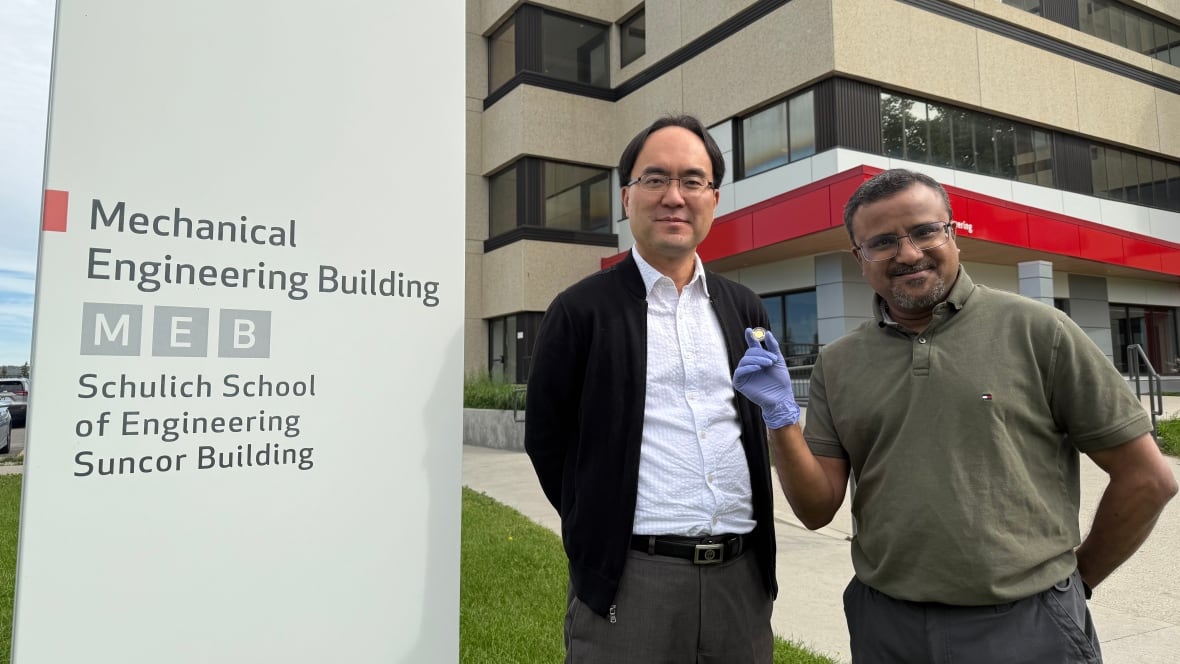Science
Calgary Researchers Innovate Airborne Molecule Sensors Inspired by Insects

Researchers at the University of Calgary have developed a groundbreaking sensor capable of detecting airborne molecules at concentrations as low as 100 parts per billion. This innovation draws inspiration from the ability of insects, such as fruit flies, to track scents from considerable distances. The study, published in the journal Nano Letters, showcases how these sensors could revolutionize applications in health care and environmental monitoring.
Insects exhibit remarkable sensitivity to scents, often flying towards areas of higher concentration. Arindam Phani, a research associate and lead on the project, explained that this principle guided their design. The sensor employs a vibrating quartz crystal coated with a thin layer of a porous material known as a metal-organic framework, enhancing its sensitivity significantly compared to the human nose.
Advancements in Detection Technology
The research team, including Sam Kim, a professor in the Schulich School of Engineering, faced challenges in creating a sensor that is both sensitive and selective. Traditional sensors often struggle to differentiate between molecules with similar characteristics. However, Phani and his team succeeded in developing a sensor that can accurately identify individual gases even at low concentrations.
One promising application for this technology is in health care. Phani envisions using the sensor for advanced breath analysis, which could assist in diagnosing conditions such as cancer and diabetes. “Our breath contains a wealth of information,” he stated. “A mixture of these low concentration molecules can provide insights into our health.” The potential to detect biomarkers at parts per billion or even less could transform breath analysis beyond traditional methods, such as alcohol breathalyzers.
Broader Applications and Future Prospects
Phani also highlighted the potential for the sensor technology in environmental monitoring, particularly for early forest fire detection. Low concentrations of nitrogen oxides are present in the air at the onset of a fire, and a sensor designed for this purpose could significantly enhance response times. “If we can quickly identify the start of a fire, it could make control efforts much easier,” he noted.
Incorporating the insect inspiration further, the researchers proposed that the sensors could be mounted on drones. This would allow for aerial data collection, facilitating the creation of 3D concentration maps, which could be invaluable for detecting gas leaks along pipelines.
Currently, the production cost of a basic sensor is approximately $25, with possibilities for further reductions as the technology moves into large-scale manufacturing. Phani expressed optimism that with continued research and development, costs could decrease significantly while maintaining functionality.
As this innovative sensor technology progresses, the next step involves collaboration with professionals in biology and medicine to explore its practical applications. With the potential to provide vital health information and enhance environmental safety, the research from the University of Calgary marks a significant advancement in sensor technology.
-

 Science2 months ago
Science2 months agoToyoake City Proposes Daily Two-Hour Smartphone Use Limit
-

 Health2 months ago
Health2 months agoB.C. Review Reveals Urgent Need for Rare-Disease Drug Reforms
-

 Top Stories2 months ago
Top Stories2 months agoPedestrian Fatally Injured in Esquimalt Collision on August 14
-

 Technology2 months ago
Technology2 months agoDark Adventure Game “Bye Sweet Carole” Set for October Release
-

 World2 months ago
World2 months agoJimmy Lai’s Defense Challenges Charges Under National Security Law
-

 Technology2 months ago
Technology2 months agoKonami Revives Iconic Metal Gear Solid Delta Ahead of Release
-

 Technology2 months ago
Technology2 months agoSnapmaker U1 Color 3D Printer Redefines Speed and Sustainability
-

 Technology2 months ago
Technology2 months agoAION Folding Knife: Redefining EDC Design with Premium Materials
-

 Business2 months ago
Business2 months agoGordon Murray Automotive Unveils S1 LM and Le Mans GTR at Monterey
-

 Technology2 months ago
Technology2 months agoSolve Today’s Wordle Challenge: Hints and Answer for August 19
-

 Lifestyle2 months ago
Lifestyle2 months agoVictoria’s Pop-Up Shop Shines Light on B.C.’s Wolf Cull
-

 Technology2 months ago
Technology2 months agoApple Expands Self-Service Repair Program to Canada









